VOCs waste gas treatment 9 major processes, scope of application and cost control
Text / VOCs frontier
With the continuous improvement of industrialization, the pollution of VOCs has further expanded. With the recent tightening of environmental protection policies, emission control of organic pollutants is even more important. Let's take a look at what technologies are available at home and abroad. What are the advantages and disadvantages of each?
1, processing principle and classification
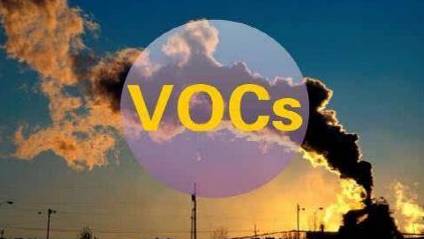
Current treatments for volatile organic pollutants include destructive, non-destructive methods, and combinations of these two methods.
Destructive methods include combustion, bio-oxidation, thermal oxidation, photocatalytic oxidation, low-temperature plasma and integrated technologies, mainly from chemical or biochemical reactions, using light, heat, microorganisms and catalysts to convert VOCs into CO2 and H2O, etc. Non-toxic inorganic small molecule compound.
Non-destructive method, ie recovery method, mainly carbon adsorption, absorption, condensation and membrane separation technology, through physical methods, control of temperature, pressure or the use of selective membranes and selective adsorbents to enrich and separate volatile organic compounds Compound.
Conventional volatile exhaust gas treatment is commonly used for absorption, adsorption removal, combustion removal, etc. In recent years, the technical body of semiconductor photocatalysts, low temperature plasma has been rapidly developed.
2, processing process analysis
1. Adsorption process
(1) Introduction to adsorption process
The adsorption method is mainly suitable for the purification of low-concentration gaseous pollutants. For high-concentration organic gases, it is usually necessary to first reduce the concentration after condensation and then carry out adsorption purification. Adsorption technology is the most classic and commonly used gas purification technology, and is one of the mainstream technologies for industrial VOCs. The key technologies of the adsorption method are adsorbents, adsorption equipment and processes, regeneration media, and post-treatment processes.
Activated carbon is widely used for adsorption and recovery of organic gases because of its large specific surface area and microporous structure. At present, the research on the adsorption of organic gases on activated carbon mainly focuses on the prediction of adsorption equilibrium, the modification of activated carbon materials and the influence of the physicochemical properties of organic matter on the adsorption performance of activated carbon.
(2) Principle and process of activated carbon adsorption process
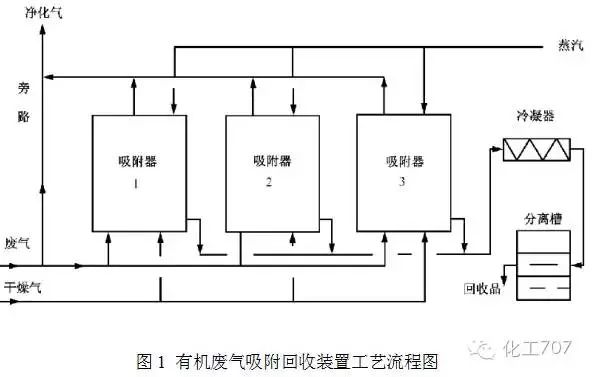
The adsorption of organic waste gas by activated carbon fiber is one of the most advanced technologies in the world. Activated carbon fiber has larger adsorption capacity and faster adsorption kinetic performance than granular activated carbon. The process of adsorption and desorption of activated carbon is shown in Figure 1.
(3) Factors affecting the adsorption process of activated carbon
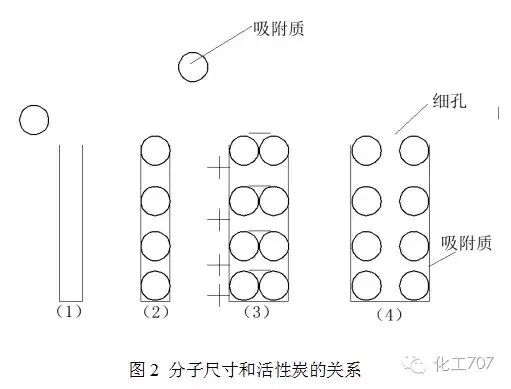
(4) The physical adsorption of activated carbon to purify the air, as shown in Figure 2:
The diameter of the molecule is larger than the diameter of the pore. Due to steric hindrance, the molecule cannot enter the pore and therefore does not adsorb;
The diameter of the molecule is equal to the diameter of the pore, and the adsorption capacity of the adsorbent is very strong, which is very suitable for low concentration adsorption;
The molecular diameter is smaller than the diameter of the pore, capillary condensation occurs in the pore, and the adsorption capacity is large;
The molecular diameter is much smaller than the diameter of the pores, the adsorbed molecules are easily desorbed, the desorption rate is high, and the adsorption amount at low concentrations is small.
(5) Advantages and disadvantages of activated carbon adsorption process
advantage:
Suitable for low concentrations of various contaminants;
The price of activated carbon is not high, the energy consumption is low, and it is economical to apply;
Solvent organics can be recovered by desorption condensation;
Easy to use, it can only work when it is in contact with the air;
Activated carbon has good acid and alkali resistance and heat resistance, and has high chemical stability.
Disadvantages:
The adsorption amount is small, and the physical adsorption has the problem of adsorption saturation. With the consumption of the adsorbent, the adsorption capacity is also weakened, and the adsorption amount may be small or the adsorption function may be lost after a period of use;
When adsorbing, there is a problem of specificity of adsorption. For mixed gas, the adsorption may be weakened, and at the same time, the molecular diameter does not match the pore size of the activated carbon, causing desorption;
2. Absorption process
(1) Introduction to absorption process
A method of absorbing a volatile gas in an industrial exhaust gas with a solution, a solvent or water to separate it from the exhaust gas is called an absorption method. The solution, solvent, and water are called absorbents. Different absorbents can absorb different harmful gases.
The absorption device used in the absorption method is called an absorber, a purifier or a scrubber. The process of the absorption method is similar to the wet dust removal process, except that the wet dust removal process uses fresh water, while the absorption method uses a solvent or a solution to purify harmful gases.
(2) Absorption process principle and process
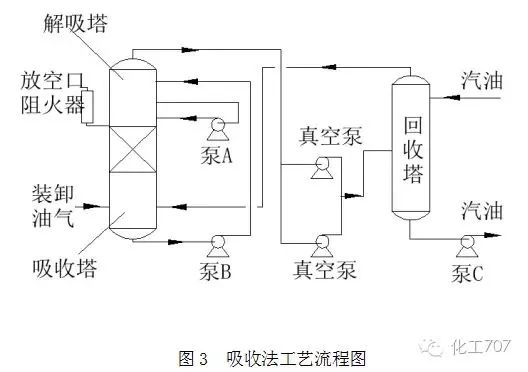
In the case of oil and gas recovery, oil and gas recovery should include the loading and unloading of oil and gas from refineries, chemical plants, and oil and gas stations. The oil and gas factory to the sales terminal is a complete system.
In the United States and European countries, one-stage and two-stage oil and gas recovery measures are usually adopted at gas stations, that is, closed oil unloading and refueling. The oil and gas in the storage tank is returned to the tanker. When refueling, vacuum auxiliary device or tank internal pressure is used to return to the storage tank. . Oil and gas recovery devices are installed in oil depots, refineries and other petroleum products distribution to recover oil and gas.
Absorption is commonly used for oil and gas recovery. The oil and gas generated during loading and unloading of oil enters the absorption tower, and the lean air is discharged from the outlet. The vacuum desorption of the absorption liquid is performed in the desorption tower, and the desorbed absorption liquid is recycled, and the recovery tower uses gasoline to recover the desorbed gas, and the exhaust gas is exhausted. Return to the absorption tower to repeat the process. The absorption of volatile organic compounds by solution absorption is usually a special absorption solution, and the choice of absorption liquid will affect the recovery effect.
(3) Advantages and disadvantages of absorption process
advantage:
The absorption process is relatively simple, the equipment investment is low, and the operation and maintenance costs are basically equivalent to the carbon adsorption method. Since the absorption medium uses kerosene and absorption liquid, there is no secondary pollution problem.
Disadvantages:
The recycling efficiency of this process is low. When the environmental protection requirements are high, it is difficult to meet the allowable oil and gas emission standards; the equipment occupies a large space; the energy consumption is high; the absorbent consumption is large, and needs to be continuously supplemented.
3. Condensation process
(1) Introduction to the condensation process
During the storage, transportation and sales of oil, some light hydrocarbon components are volatilized into the atmosphere, resulting in waste of resources and environmental hazards. At the same time, organic solvents are widely used in industrial production. Every year, a large amount of organic solvents are volatilized into the air, endangering human health and causing serious environmental pollution. Recycling these volatile organic compounds in a proper way can not only reduce the production cost of the enterprise, but also has great environmental benefits.
Condensation is an effective method for recovering VOCs. The basic principle is to use gaseous contaminants to have different saturated vapor pressures at different temperatures and pressures. By lowering the temperature and increasing the pressure, some organic matter is condensed to make VOCs. It can be purified and recycled.
(2) Condensation process principle and process
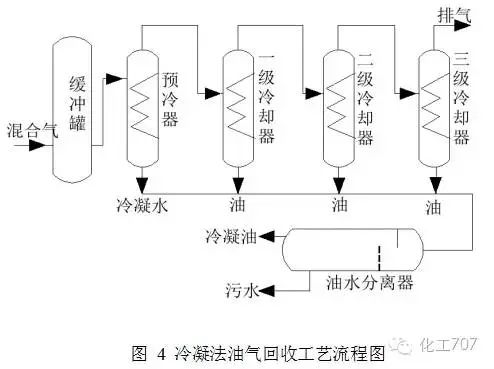
The condensing oil and gas recovery equipment adopts multi-stage cascade or self-cascade refrigeration technology. Although the system flow is relatively complicated, the key components of the compressor and the throttling mechanism have all achieved localized production, and the investment and operating costs are relatively low.
According to the working principle of the heat exchange tube, it can be divided into a refrigerant circuit and a gas circuit portion, and the heat exchange tubes are connected to two parts. In the gas circulation part, the low-temperature refrigerant exchanges heat with the hot organic solvent mixed gas in the heat exchanger, and the organic solvent is liquefied and recovered, and the refrigerant flows into the liquid storage tank.
In the refrigerant circuit, the compressor compresses the refrigerant into a high-temperature and high-pressure gas refrigerant, liquefies through an air-cooled condenser, and through the drying filter, the cold liquid refrigerant in the refrigerant-refrigerant heat exchanger exchanges heat with the refrigerant, and the low temperature The refrigerant enters the liquid storage tank, and the refrigerant enters the compressor inlet through the suction filter to complete the entire refrigerant refrigerant heat exchange process.
(3) Factors affecting the condensation process
The condensing separation method recovers light hydrocarbons to cool down the raw material gas. According to the principle, it can be divided into throttling expansion refrigeration and expansion machine expansion refrigeration. According to the process, it can be divided into refrigerant refrigeration (such as propane refrigeration), throttling expansion refrigeration, expander expansion refrigeration, and mixed refrigeration (adding refrigerant cooling on the basis of expander expansion refrigeration or process fluid self-throttle expansion refrigeration).
The separation method includes rectification separation of the rectification system, and the separator phase is separated and separated. This process typically involves dewatering, pressurization (low pressure gas), rectification, and refrigeration. The choice of each part of the above condensation process will affect the final condensation effect.
(4) Advantages and disadvantages of condensation process
advantage:
The condensation method utilizes different recovery of the boiling point of the substance and is suitable for organic substances with a relatively high boiling point. The method has the advantages of high recovery purity, simple equipment process and low energy consumption; and has compact equipment, small space occupation, high automation degree and convenient maintenance. Good safety, the output is liquid oil can be directly used and so on;
Disadvantages:
The single condensation method needs to reach a very low temperature to meet the standard, and the power consumption is huge. It is not a real "energy saving and emission reduction".
4. Membrane separation process
(1) Introduction to membrane separation process
In the process of oil exploitation and storage, some oils are volatilized into the oil and gas formed in the atmosphere, except for air, mainly C4-C5 and a small amount of aromatic hydrocarbons. These organic vapor emissions not only cause serious waste of resources, but also have a great impact on air quality, which in turn affects human health. At present, the separation and recovery methods of organic vapors are mainly condensation, activated carbon adsorption, membrane separation, and solvent absorption. Membrane separation technology is a more efficient separation method.
(2) Principle and process of membrane separation process
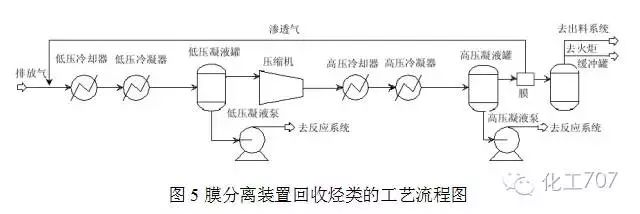
The membrane separation organic vapor recovery system is separated by a dissolution-diffusion mechanism. After the gas molecules are in contact with the membrane, they dissolve on the surface of the membrane, and a concentration gradient is generated on both sides of the membrane, because the diffusion and diffusion rates of different gas molecules through the dense membrane are different, so that the gas molecules are from the membrane to the membrane. Side diffusion, and finally desorption from the other side of the membrane, and finally achieve the purpose of separation.
After the membrane separation device is installed in the high-pressure condenser, before the buffer tank, due to insufficient capacity of the exhaust gas compressor, only a part of the gas passes through the membrane separation device, and other portions directly enter the buffer tank, and the permeate gas returns to the low-pressure cooler, and the exhaust gas enters the buffer tank. .
(3) Factors affecting the membrane separation process
The material of the support layer has an important influence on the permeation rate and the recovery rate of hydrocarbon VOCs. For the support layer of the same material, the permeation rate and the recovery rate of hydrocarbon VOCs increase with the decrease of the pore size, but when the pore diameter is reduced to a certain critical value As the value continues to decrease, the permeation rate and hydrocarbon VOCs recovery will decrease.
(4) Advantages and disadvantages of membrane separation process
advantage:
Membrane separation technology is a cutting-edge technology in the separation science of modern petrochemical disciplines. It has the characteristics of small investment, quick effect, simple process, high recovery rate, low energy consumption and no secondary pollution, and has high scientific and technological content;
Disadvantages:
The investment is large; the membrane country has low yield, high price, and short membrane life; the membrane separation device requires steady flow, steady gas, and high operation requirements.
5. Combustion process
(1) Introduction to the combustion process
One type of VOCs treatment is a so-called destructive technique that converts VOCs into non-toxic or less toxic inorganics such as carbon dioxide, water, and hydrogen chloride by chemical or biological techniques. Combustion is one such technology.
The combustion method is divided into a direct combustion method and a catalytic combustion method. The direct combustion method is suitable for treating exhaust gas of high concentration VOCs. Because its operating temperature is usually 800-1200 °C, the process energy cost is high, and by-products such as dioxin and NOx are prone to occur in the combustion exhaust gas; due to the concentration of VOCs in the exhaust gas Generally low, relying solely on the heat of reaction, it is generally difficult to maintain the temperature required for the reaction.
In order to improve thermal economy, a lot of research has been carried out, one direction is to improve the performance of the catalyst to lower the reaction temperature. The other direction is to study new process technologies and new reactor designs to enable the reaction to be self-heating at higher temperatures.
(2) Principle and process of combustion process
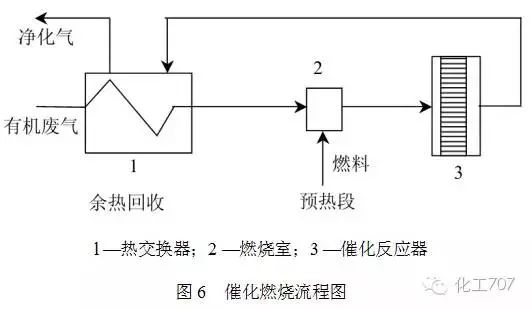
In catalytic combustion, preheating is a basic form of flow. The organic waste gas is heated in the preheating chamber before entering the reactor. Since the organic exhaust gas temperature is lower than 100 degrees Celsius, the concentration is low and the heat cannot be self-sufficient. After combustion purification, heat is exchanged with untreated exhaust gas to recover part of the heat. Gas or electric heating is a common method used in this process and is heated to the ignition temperature required for the catalytic reaction.
(3) Factors influencing the combustion process
The choice of catalytic combustion catalysts is critical and its performance plays a decisive role in eliminating efficiency and energy consumption. For volatile organic compound oxidation catalysts generally can be divided into two categories: precious metal catalysts (platinum, palladium, etc.) and metal oxide catalysts (copper, chromium, manganese, etc.), precious metal catalysts are widely used in the catalytic combustion of volatile organic compounds, Because of its good light-off activity. Among the noble metal catalysts used to catalyze the oxidation of VOCs, platinum is more active than palladium.
(4) Advantages and disadvantages of the combustion process
advantage:
Compared with the direct combustion method, the auxiliary fuel cost is low, the secondary pollutant NOx generation amount is small, the combustion equipment volume is small, and the VOCs removal rate is high;
Disadvantages:
Catalysts are relatively expensive and require that the exhaust gas contain no ingredients that would cause catalyst deactivation.
6. Biological filtration process
(1) Introduction to biological filtration process
Biodegradation of various organic substances and certain inorganic substances by utilizing the metabolic process of microorganisms can effectively remove pollutants in industrial waste gas, which is a biological method for treating organic waste gas.
The first idea to use microbial treatment of waste gas was Bach, who used a soil filter bed to treat H2S-containing malodorous gases from sewage treatment plants in 1923. In many parts of Germany and the Netherlands, this technology has been used on a large scale and successfully to control odors, volatile organic compounds and toxic emissions in the air. Many common air pollutants have been controlled more than 90%.
(2) Principle and process of biological filtration process
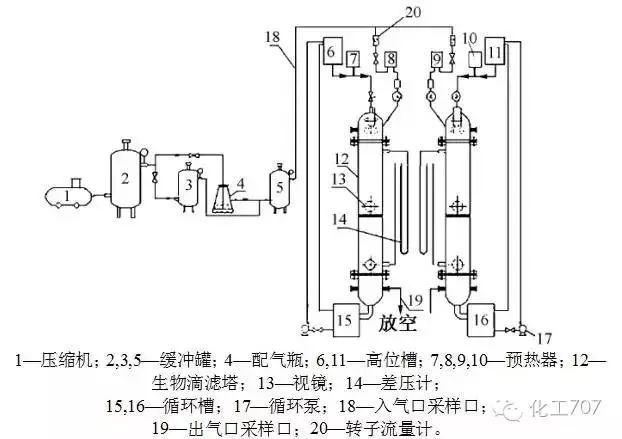
The biological filtration process system is composed of a gas conveying device, a spraying device and a filter tower body. The volatile organic compound is pre-wet by pressure, and is contacted with the biofilm on the surface of the filler layer in the filter tower. The volatile organic compounds are transferred from the gas phase to the biofilm, and then decomposed and utilized by the microorganisms, and are converted into carbon dioxide, water and others. The molecular substance is then discharged from the purified gas. The spray device periodically sprays the spray to the filler layer to adjust the moisture content, pH and nutrient content of the filler layer.
(3) Factors affecting the biological filtration process
Filler: In the bio-drip filter, the biofilm grows on the surface of the filler, and the gaseous organic stream passes through the gap between the fillers. The specific surface area of ​​the filler reflects the amount of microorganisms to a certain extent. The porosity affects the flow rate of gas and liquid, and the height of the filler layer is important for the treatment of organic matter.
Nutrient solution: The nutrients, trace elements and buffers in the biological trickling filter are evenly sprayed on the filler to provide the nutrients needed for the growth and reproduction of the biological flora in the biofilm. The removal rate of volatile organic compounds is affected to some extent by the flow rate of nutrient solution, the content of nitrogen and phosphorus, and the like.
Intake: During the operation of the bio-drip filter, the gas flow rate and the concentration of the inlet gas have a significant effect on the removal efficiency of the gas itself.
(4) Advantages and disadvantages of biological filtration process
advantage:
Wide application range, high processing efficiency, simple process, low cost and no secondary pollution.
Disadvantages:
The removal rate of VOCs with high concentration, poor biodegradability and difficult biodegradation is low.
7. Plasma process
(1) Introduction to plasma process
Plasma contaminant control technology utilizes gas discharge to produce highly reactive particles that react with various organic and inorganic contaminants to cause the contaminant molecules to be decomposed into small molecular compounds or oxidized into readily treatable compounds.
The biggest feature of this technology is that it can destroy and decompose many pollutants efficiently and conveniently. The equipment used is simple, takes up less space, and is suitable for various working environments.
(2) Plasma process principle and process
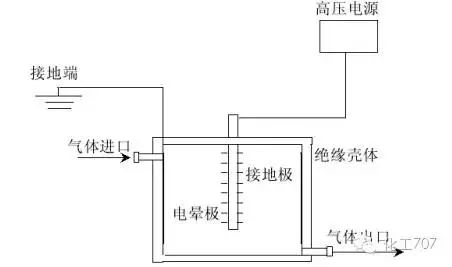
The main treatment for volatile organic compounds is corona discharge. The main degradation mechanism is as follows: Under the applied electric field, the electrons in the electrode space acquire energy and begin to accelerate. The electrons and gas molecules collide with each other during the movement, so that the gas molecules are excited, ionized or adsorbed as negative ions.
(3) Factors influencing the plasma process
In the degradation process, the selection and control of the electrode voltage is the main content, which affects the discharge of the discharge medium and the electron carrying capacity, and a series of subsequent reactions, which in turn affect the degradation efficiency; at the same time, the electrode voltage is also achieved as the method An important parameter for commercial applications, so the choice of electrode voltage is especially critical.
The low temperature plasma degradation VOCs are closely related to the electrode voltage, and are also affected by the reactor structure, the reaction background atmosphere, the water content of the VOCs, the discharge frequency, the discharge voltage, the chemical structure of the VOCs, the type of catalyst, and the low-temperature plasma discharge form. The influence of reaction temperature and initial concentration of VOCs, among which the influence of gas concentration and gas flow rate is dominant.
(4) Advantages and disadvantages of plasma process
advantage:
The treatment efficiency is high, the operation cost is low, and the removal efficiency of the aromatic hydrocarbon is particularly high.
Disadvantages:
The treatment efficiency of high-concentration VOCs is generally low, and currently mainly stays in the laboratory stage, lacking practical applications.
8 photocatalytic oxidation process
(1) Introduction to photocatalytic oxidation process
Photochemical and photocatalytic oxidation methods are currently an advanced oxidation technology. A photocatalytic reaction is a chemical reaction carried out under the action of light. After the molecule absorbs electromagnetic radiation of a specific wavelength, the molecule reaches an excited state, and then a chemical reaction occurs to generate a new substance or become an initiator of the thermal reaction.
(2) Principle and process of photocatalytic oxidation process
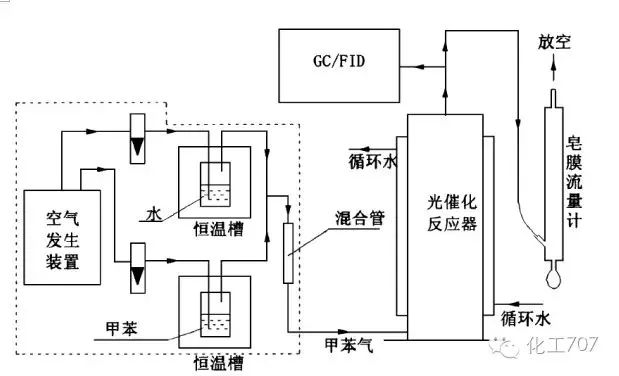
Ti02, a semiconductor material, has its own optoelectronic properties that determine its use as a photocatalyst. The band structure of a semiconductor is usually an electron-filled low energy valence band (VB) and an empty high-energy conduction band (CB). The area between the conduction band and the valence band is called a forbidden band.
When the light energy of the illuminating semiconductor is equal to or greater than the forbidden band width, its valence band electrons are excited, enter the conduction band across the forbidden band, and generate corresponding holes in the valence band. The electrons are excited from the valence band to the conduction band, and some of the electrons and holes separated after the excitation are further reacted.
Photocatalytic reaction mechanism is shown in the figure:
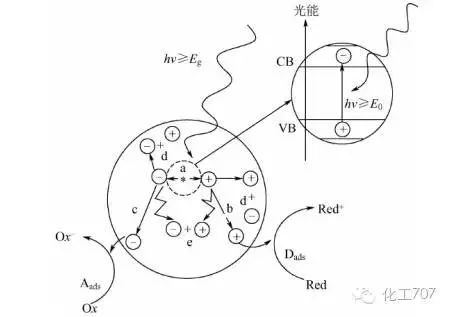
(3) Factors affecting the photocatalytic oxidation process
Studies have shown that the initial concentration of the reactants has a significant effect on the photocatalytic efficiency or degradation rate. The photocatalytic efficiency fluctuates with the increase of the initial concentration, and there is a significant concentration transition point; the photocatalytic degradation efficiency of the low concentration target is greater than the photocatalytic degradation efficiency of the high concentration target.
There is no consistent conclusion on the effect of humidity on the photocatalytic reaction. There are large differences in experimental conditions for different compounds or different concentrations.
(4) Advantages and disadvantages of photocatalytic oxidation process
advantage:
High processing efficiency and low operating cost, suitable for low concentration and wide range of VOCs, especially for aromatics removal efficiency;
Disadvantages:
The treatment efficiency of high concentration VOCs is general; it mainly stays in the laboratory stage and lacks practical application.
9. Zeolite runner + RTO process
(1) Process principle:
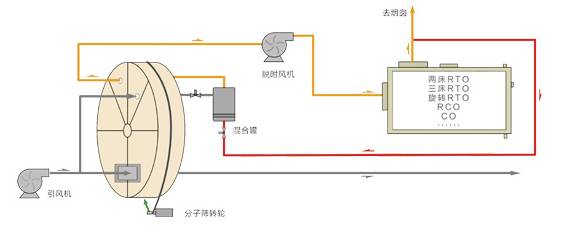
After the VOCs exhaust gas passes through the zeolite concentration runner, it can be effectively adsorbed into the zeolite for the purpose of removal. The volatile gas adsorbed by the zeolite is cleaned and discharged directly into the atmosphere through the chimney, and the rotor continues to rotate at a speed of 1-6 rpm.
At the same time, the adsorbed volatile organic matter is transported to the desorption zone, and the volatile organic matter is desorbed by a small heating gas in the desorption zone, and the desorbed zeolite rotor is rotated to the adsorption zone to continuously adsorb the volatile organic gas. . The desorbed concentrated organic waste gas is sent to an incinerator for combustion into carbon dioxide and water vapor to the atmosphere.
2. Technical characteristics
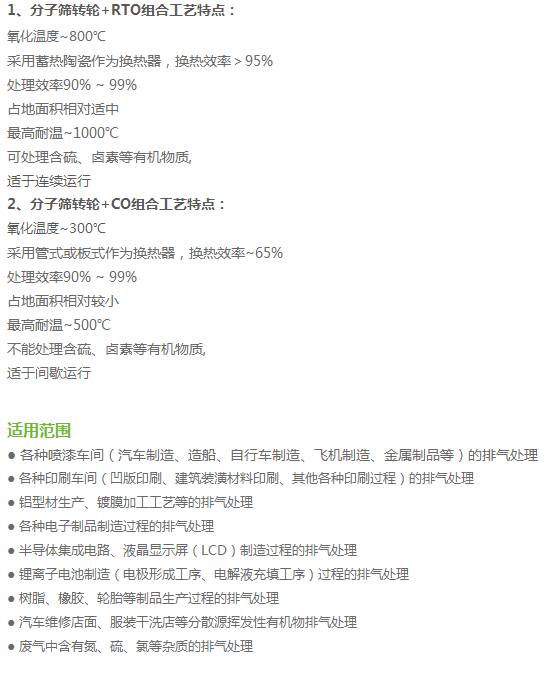
3, process selection
1. Technology selection
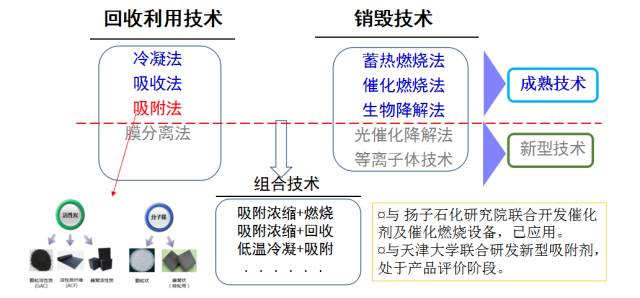
2. According to VOCs concentration and flow rate
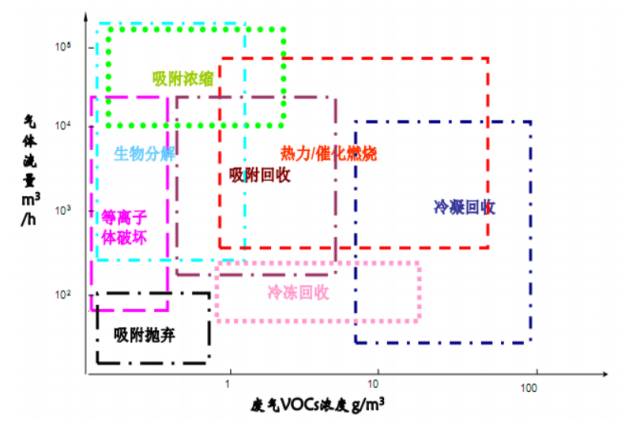
3. Relative cost
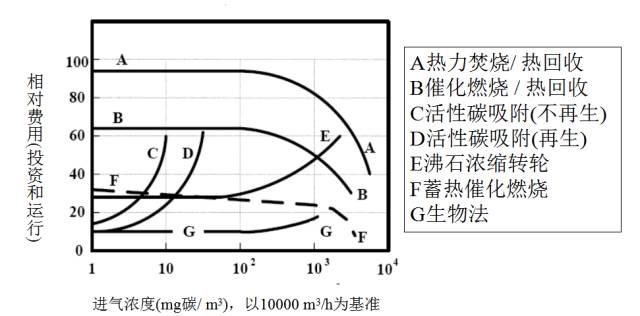
Stainless Steel Shaker Bottles are made from high-grade 18/8 stainless steel. This material is food grade, non-toxic, durable and easy to clean.
And we got a lot of different kinds of Stainless Steel Bottles. For example: Stainless Steel Cola Bottle, a classic design that is popular in the market and easy to use, also looks good. Speaking of looking, our Cola Bottle comes in changeable colors and diverse patterns.
Blender Bottle Strada 2 Pack,Insulated Shaker Bottle,Glass Shaker Bottle,Insulated Stainless Steel Blender Bottle,Metal Shaker Bottle
Ningbo Auland International Co.,Ltd. , https://www.everdrinkingbottle.com